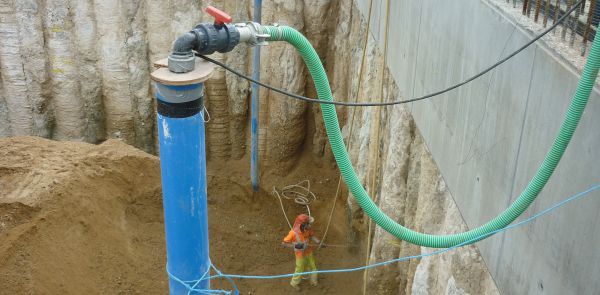What are Deepwells?
Deepwells are used for dewatering of excavations when the drawdown is required below 6 metres in depth and the permeability of the targeted soil is moderate to high. In addition, deepwells may be used to underdrain less permeable overlying strata in certain ground conditions.
An array of deepwells is installed either internally or externally and may work to control groundwater in conjunction with a physical cut-off wall, such as a sheet-pile, secant-pile, or diaphragm wall. Each deepwell typically consists of a borehole, lined with a slotted screen and annular filter pack through the target stratum. An electric submersible pump is installed within the liner close to the base of the well and connected to the surface via a riser pipe. Water is then pumped into a common header main before being discharged or recharged back to the ground.

As water is pumped from a deepwell, a hydraulic gradient is formed and water flows into the well, forming a cone of depression around the well in which there is little or no water remaining in the pore spaces of the surrounding soil.
Deepwells are typically drilled using cable percussive or rotary drilling methods, usually terminating in a 300mm or 250mm bore. In competent ground, such as chalk or sandstone, wells may be installed with an open-hole section as per a traditional water supply well.
Where soil permeability is low, it is common to seal the well and apply a vacuum to improve the well yield and the overall drawdown of a system. Experience shows that applying a vacuum to a low yielding well, such as the one installed in the Lambeth Group in London, can improve the rate of extraction by 50%. For depths in excess of 45-50m, vacuum deepwells are usually more efficient than ejectors wells.
Where there is a need to minimise external of remote drawdowns, maybe due to settlement concerns or risk of contaminant migration, water can be recharged back to ground using recharge or reinjection wells. These wells are very similar in design to a deepwell, but often recharge the water to different stratum.

